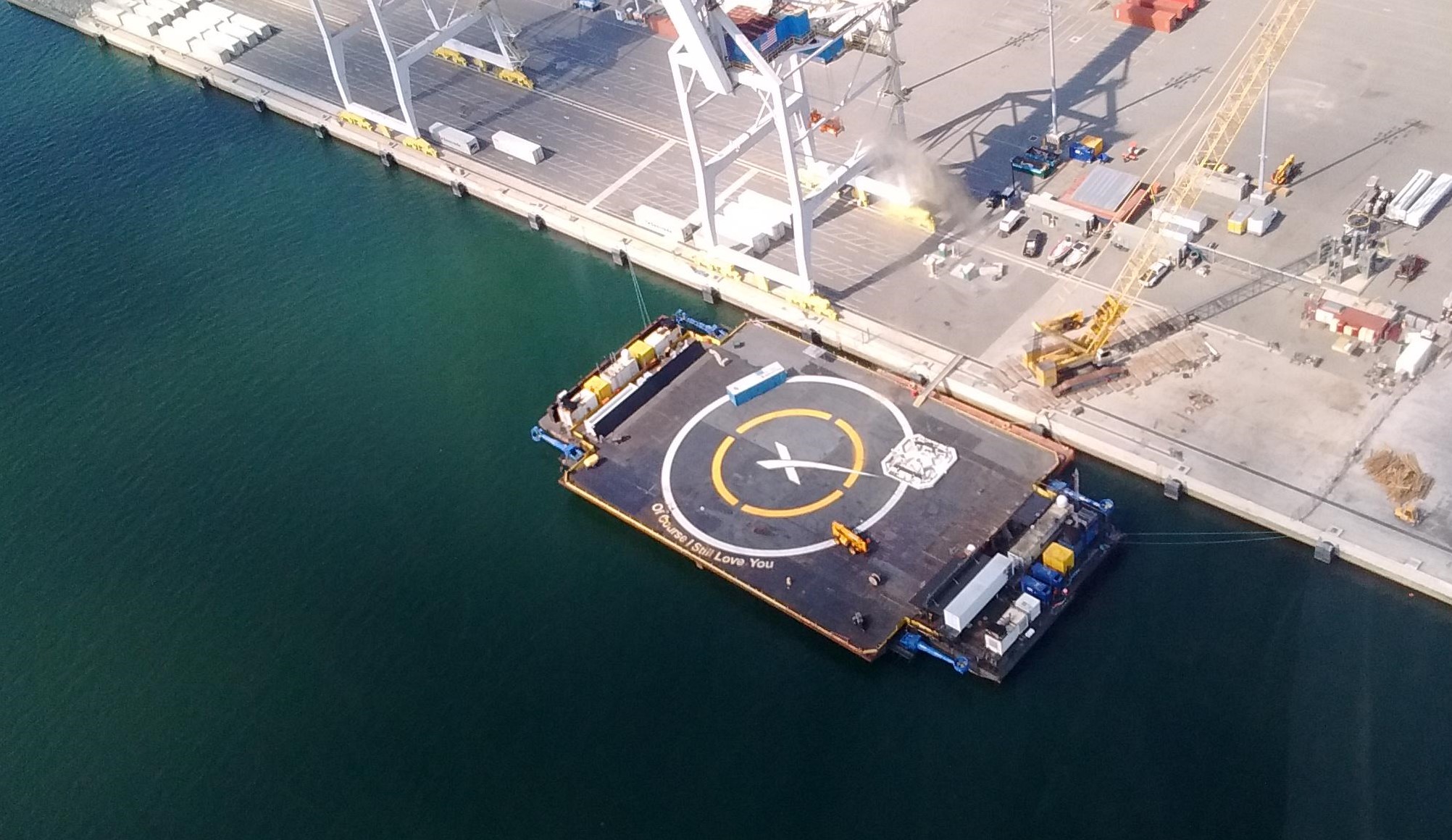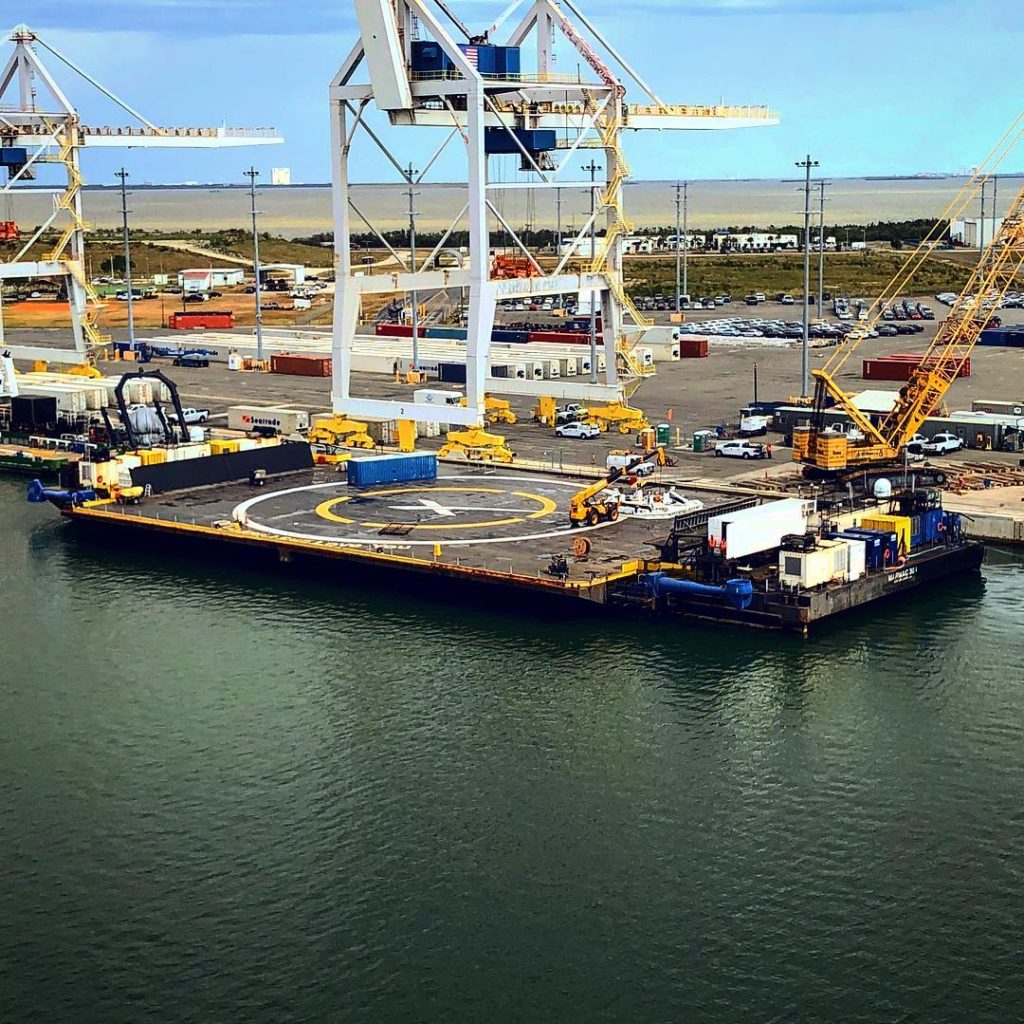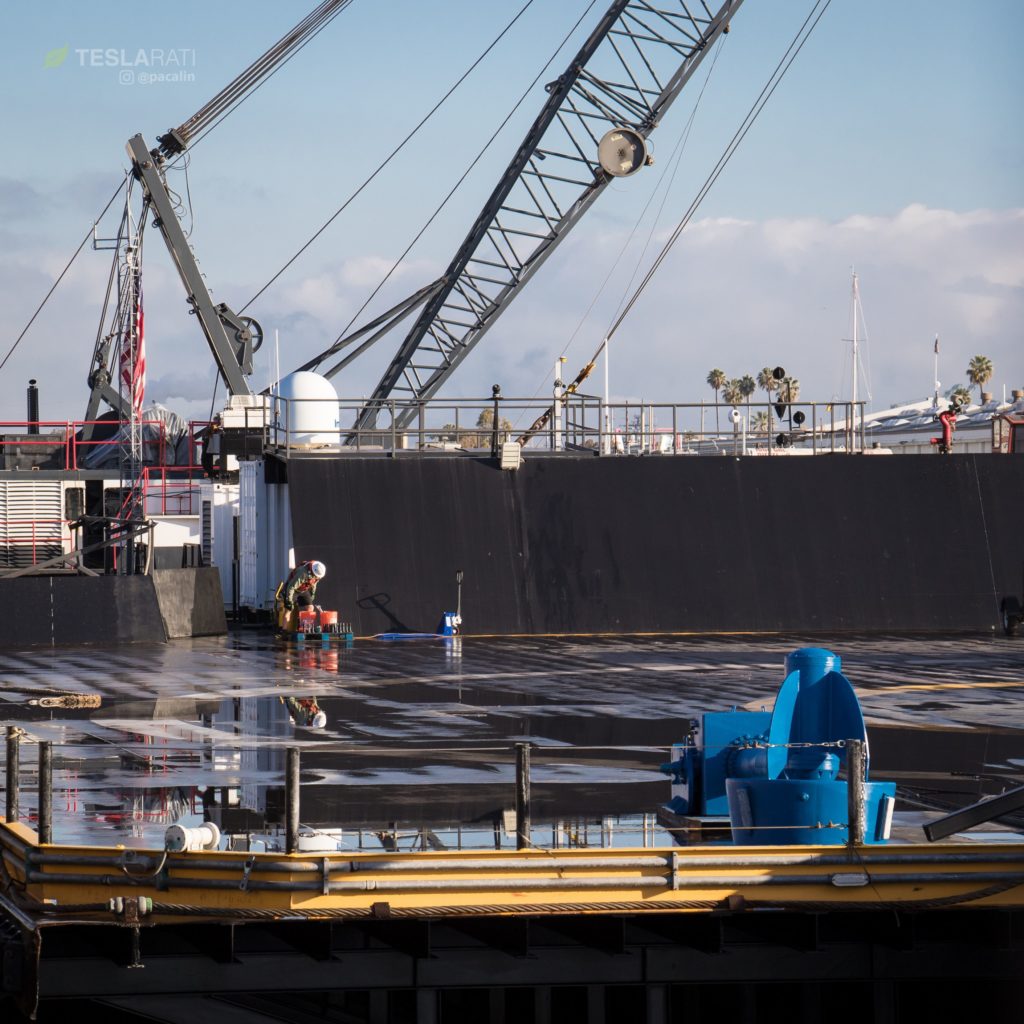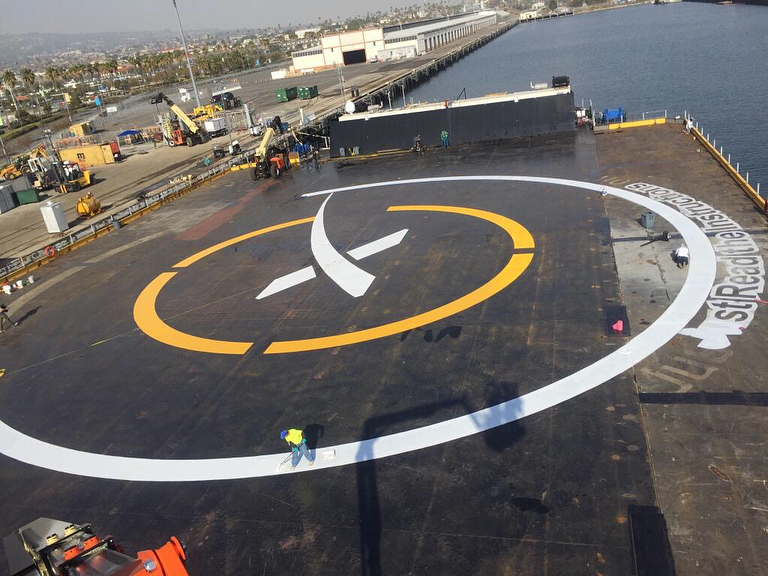

News
SpaceX’s drone ship fleet spied prepping for future rocket recoveries
Just shy of three weeks since SpaceX’s last launch and the better part of half a year since the last successful ocean recovery, both of the company’s drone ships have been spotted in recent weeks being refurbished, refitted, and prepared for a return to the ocean.
The unusual drought of drone ship landings was nearly brought to an end in early March, but that recovery attempt – following the successful launch of Hispasat 30W-6 – was precluded by extreme weather in the landing zone, forcing booster 1044 to soft-land in the Atlantic with a swan call of landing legs and titanium grid fins. Several weeks before 1044’s demise, the inaugural launch of Falcon Heavy also saw the first failed booster recovery attempt since June 2016, ending a successful streak of 17 flawless Falcon 9 recoveries – though both side boosters did manage a spectacular, synchronized landing at LZs 1 and 2.
Before the Falcon Heavy attempt, East coast drone ship Of Course I Still Love You (OCISLY) successfully recovered a Falcon 9 booster for the last time in late October 2017, a handful of weeks after the successful recovery of SES-11 – the source of a small fire that famously destroyed SpaceX’s robotic stage securer, nicknamed Roomba or Octagrabber. Over the several months, since it was damaged, Octagrabber has gradually undergone refurbishment at SpaceX’s Port Canaveral berth, most recently appearing back on OCISLY for post-refurb testing.
With the introduction of Falcon 9 Block 5 presumably a month or less away, the days of expending once flight-proven boosters will almost certainly be over, aside from missions that truly require the booster’s full performance. As discussed yesterday, regardless of whether Block 5 is truly ready for the limelight, SpaceX is no more than two months away from effectively running out of all older boosters: the once-flown B1045 (TESS) will likely be the only flight-worthy heritage booster remaining by early May. In other words, every single SpaceX launch in the second half of 2018 is all but guaranteed to attempt recovery, either by land or sea.
- OCISLY as seen by Tom Cross on March 5, readying for a busy future of rocket recoveries. (Tom Cross)
- Roomba was spied aboard OCISLY for the first time in months earlier this month. (Instagram /u/grimlok77)
OCISLY is effectively prepared to support these upcoming recovery attempts, and its Octagrabber may be as well. However, OCISLY was reportedly damaged by Falcon Heavy’s center core, despite the fact that it quite visibly missed the drone ship. Presumably, the forlorn booster acted as a sort of depth charge, thus damaging beyond repair the drone ship’s sensitive maneuvering and station-keeping thrusters. Before Falcon Heavy, it’s likely that the same fire that burned Octagrabber also damaged the hydraulic systems of one or several of OCISLY’s thrusters. These conclusions are supported by the fact that SpaceX’s West coast drone ship, Just Read The Instructions (JRTI), has visibly been stripped of its functional thrusters, presumably used to keep OCISLY operational in anticipation of Falcon Heavy and later Hispasat 30W-6.
Mr Steven, SpaceX’s only current fairing recovery vessel, has also been spotted conducting some sort of sea trials just off the shore of Port of San Pedro and LA, presumably honing recovery operations and giving its pilots time to practice catching fairings. Following the launch of PAZ and SpaceX’s own prototype Starlink satellites, the company managed its first-ever intact fairing recovery, although it missed Mr Steven’s net by a few hundred feet. As stated by Musk, it should be relatively easy to go from missing by a few hundred feet to successfully catching the fairing, and it’s likely that the imminent launch of Iridium-5 (7:19 am PDT, March 29) will attempt to close that gap and actually catch a fairing halve. On the other hand, the booster – flight-proven during the October 2017 launch of Iridium-3 – will likely soft-land in the Pacific Ocean because JRTI is currently unable to support ocean recoveries, lacking two of its four thrusters.
- Teslarati photographer Pauline Acalin took a trip down to Port of San Pedro to check up on JRTI, March 25. (Pauline Acalin)
- Note one of JRTI’s thrusters here, quite clearly not installed. A second one sits just out of sight on the right. (Pauline Acalin)
- SpaceX’s West coast drone ship Just Read The Instructions getting some much needed fresh paint. (Instagram, anonymous)
Follow us for live updates, behind-the-scenes sneak peeks, and a sea of beautiful photos from our East and West coast photographers.
Teslarati – Instagram – Twitter
Tom Cross – Twitter
Pauline Acalin – Twitter
Eric Ralph – Twitter
News
Tesla begins Robotaxi certification push in Arizona: report
Tesla seems serious about expanding its Robotaxi service to several states in the coming months.

Tesla has initiated discussions with Arizona transportation regulators to certify its driverless Robotaxi service in the state, as per a recent report from Bloomberg News. The move follows Tesla’s launch of its Robotaxi pilot program in Austin, Texas, as well as CEO Elon Musk’s recent comments about the service’s expansion in the Bay Area.
The Arizona Department of Transportation confirmed to Bloomberg that Tesla has reached out to begin the certification process for autonomous ride-sharing operations in the state. While details remain limited, the outreach suggests that Tesla is serious about expanding its driverless Robotaxi service to several territories in the coming months.
The Arizona development comes as Tesla prepares to expand its service area in Austin this weekend, as per CEO Elon Musk in a post on X. Musk also stated that Tesla is targeting the San Francisco Bay Area as its next major market, with a potential launch “in a month or two,” pending regulatory approvals.
Tesla first launched its autonomous ride-hailing program on June 22 in Austin with a small fleet of Model Y vehicles, accompanied by a Tesla employee in the passenger seat to monitor safety. While still classified as a test, Musk has said the program will expand to about 1,000 vehicles in the coming months. Tesla will later upgrade its Robotaxi fleet with the Cyercab, a two-seater that is designed without a steering wheel.
Sightings of Cybercab castings around the Giga Texas complex suggests that Tesla may be ramping the initial trial production of the self-driving two-seater. Tesla, for its part, has noted in the past that volume production of the Cybercab is expected to start sometime next year.
In California, Tesla has already applied for a transportation charter-party carrier permit from the state’s Public Utilities Commission. The company is reportedly taking a phased approach to operating in California, with the Robotaxi service starting with pre-arranged rides for employees in vehicles with safety drivers.
News
Tesla sets November 6 date for 2025 Annual Shareholder Meeting
The automaker announced the date on Thursday in a Form 8-K.

Tesla has scheduled its 2025 annual shareholder meeting for November 6, addressing investor concerns that the company was nearing a legal deadline to hold the event.
The automaker announced the date on Thursday in a Form 8-K submitted to the United States Securities and Exchange Commission (SEC). The company also listed a new proposal submission deadline of July 31 for items to be included in the proxy statement.
Tesla’s announcement followed calls from a group of 27 shareholders, including the leaders of large public pension funds, which urged Tesla’s board to formally set the meeting date, as noted in a report from The Wall Street Journal.
The group noted that under Texas law, where Tesla is now incorporated, companies must hold annual meetings within 13 months of the last one if requested by shareholders. Tesla’s previous annual shareholder meeting was held on June 13, 2024, which placed the July 13 deadline in focus.
Tesla originally stated in its 2024 annual report that it would file its proxy statement by the end of April. However, an amended filing on April 30 indicated that the Board of Directors had not yet finalized a meeting date, at least at the time.
The April filing also confirmed that Tesla’s board had formed a special committee to evaluate certain matters related to CEO Elon Musk’s compensation plan. Musk’s CEO performance award remains at the center of a lengthy legal dispute in Delaware, Tesla’s former state of incorporation.
Due to the aftermath of Musk’s legal dispute about his compensation plan in Delaware, he has not been paid for his work at Tesla for several years. Musk, for his part, has noted that he is more concerned about his voting stake in Tesla than his actual salary.
At last year’s annual meeting, TSLA shareholders voted to reapprove Elon Musk’s compensation plan and ratified Tesla’s decision to relocate its legal domicile from Delaware to Texas.
Elon Musk
Grok coming to Tesla vehicles next week “at the latest:” Elon Musk
Grok’s rollout to Tesla vehicles is expected to begin next week at the latest.

Elon Musk announced on Thursday that Grok, the large language model developed by his startup xAI, will soon be available in Tesla vehicles. Grok’s rollout to Tesla vehicles is expected to begin next week at the latest, further deepening the ties between the two Elon Musk-led companies.
Tesla–xAI synergy
Musk confirmed the news on X shortly after livestreaming the release of Grok 4, xAI’s latest large language model. “Grok is coming to Tesla vehicles very soon. Next week at the latest,” Musk wrote in a post on social media platform X.
During the livestream, Musk and several members of the xAI team highlighted several upgrades to Grok 4’s voice capabilities and performance metrics, positioning the LLM as competitive with top-tier models from OpenAI and Google.
The in-vehicle integration of Grok marks a new chapter in Tesla’s AI development. While Tesla has long relied on in-house systems for autonomous driving and energy optimization, Grok’s integration would introduce conversational AI directly into its vehicles’ user experience. This integration could potentially improve customer interaction inside Tesla vehicles.
xAI and Tesla’s collaborative footprint
Grok’s upcoming rollout to Tesla vehicles adds to a growing business relationship between Tesla and xAI. Earlier this year, Tesla disclosed that it generated $198.3 million in revenue from commercial, consulting, and support agreements with xAI, as noted in a report from Bloomberg News. A large portion of that amount, however, came from the sale of Megapack energy storage systems to the artificial intelligence startup.
In July 2023, Musk polled X users about whether Tesla should invest $5 billion in xAI. While no formal investment has been made so far, 68% of poll participants voted yes, and Musk has since stated that the idea would be discussed with Tesla’s board.
-

 Elon Musk1 week ago
Elon Musk1 week agoTesla investors will be shocked by Jim Cramer’s latest assessment
-

 Elon Musk20 hours ago
Elon Musk20 hours agoxAI launches Grok 4 with new $300/month SuperGrok Heavy subscription
-

 Elon Musk3 days ago
Elon Musk3 days agoElon Musk confirms Grok 4 launch on July 9 with livestream event
-

 News7 days ago
News7 days agoTesla Model 3 ranks as the safest new car in Europe for 2025, per Euro NCAP tests
-

 Elon Musk2 weeks ago
Elon Musk2 weeks agoA Tesla just delivered itself to a customer autonomously, Elon Musk confirms
-

 Elon Musk1 week ago
Elon Musk1 week agoxAI’s Memphis data center receives air permit despite community criticism
-

 Elon Musk2 weeks ago
Elon Musk2 weeks agoTesla’s Omead Afshar, known as Elon Musk’s right-hand man, leaves company: reports
-

 News2 weeks ago
News2 weeks agoXiaomi CEO congratulates Tesla on first FSD delivery: “We have to continue learning!”
























